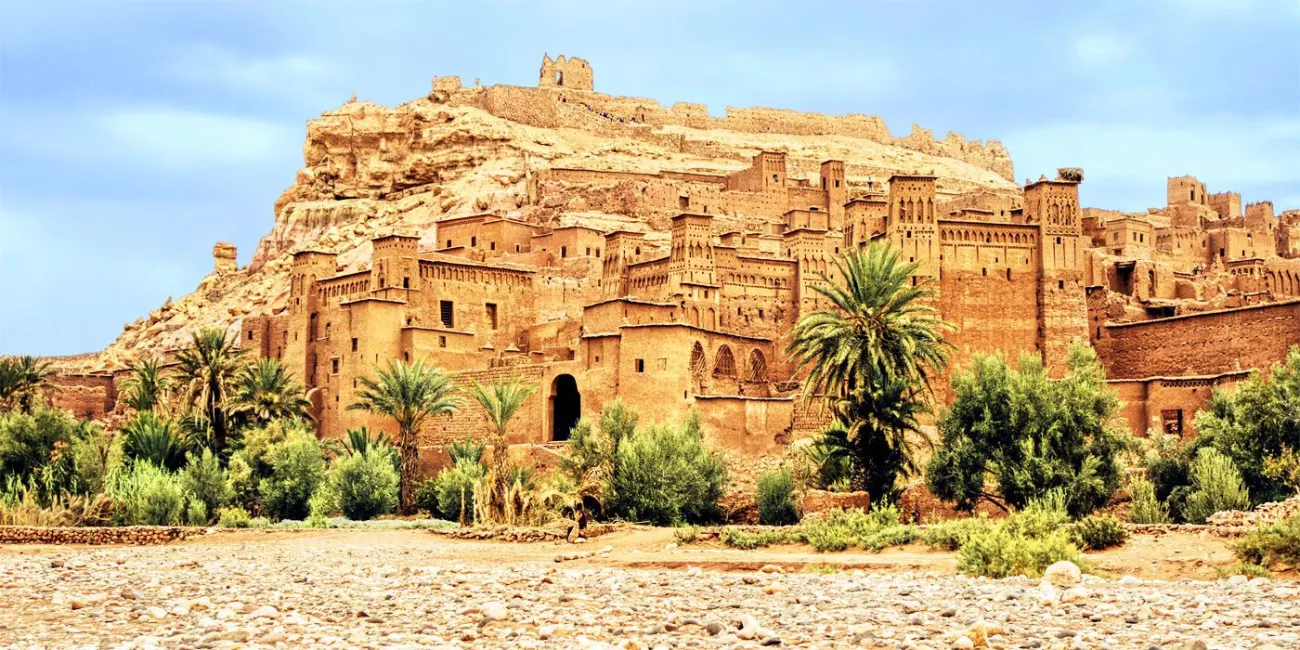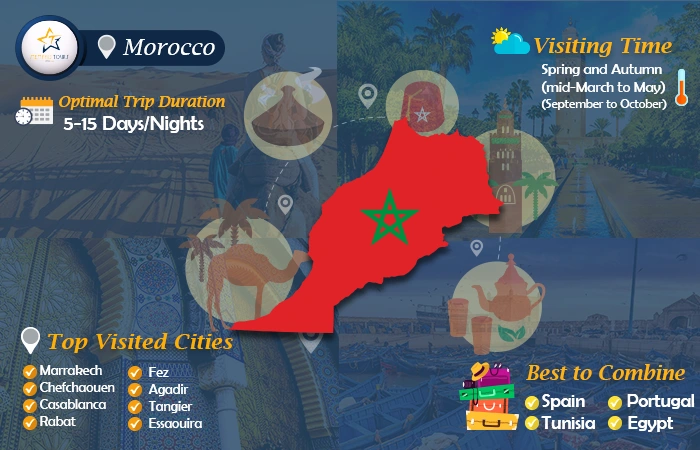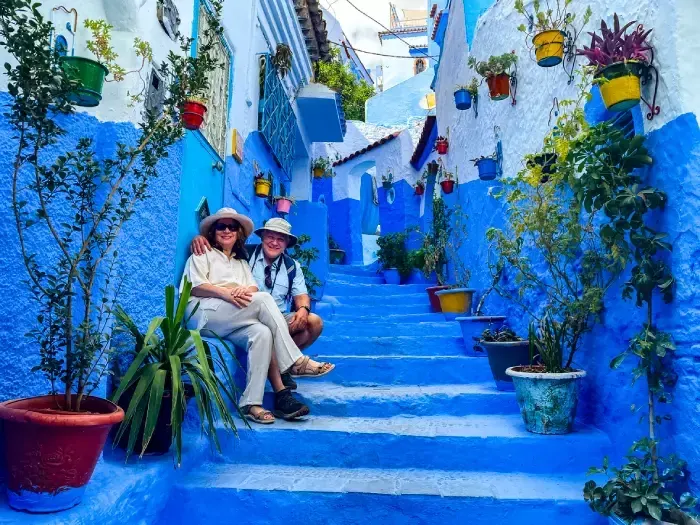Morocco Vacations: Everything you Need to Know

Morocco beckons as an extraordinary gateway that transports you far beyond the familiar rhythms of European destinations into a realm where Western influence fades into something far more captivating. This North African kingdom presents a remarkable duality of rural landscapes where cash transactions still reign supreme, while urban centers welcome modern payment methods, creating an intriguing tapestry of old-world traditions seamlessly interwoven with contemporary conveniences.
The kingdom's infrastructure tells a fascinating story of ambition and achievement. Morocco houses Africa's pioneering high-speed rail line, the magnificent Al Boraq, which rockets passengers between Casablanca and Tangier while an extensive network of conventional trains links the nation's major population centers. Yet certain peculiarities demand your attention before embarking on this North African odyssey. The Moroccan dirham operates as a closed currency - you simply cannot acquire it beyond the country's borders. Weather patterns reveal another intriguing discovery: spring months from March through May and autumn's September to November window offer the most agreeable conditions for exploration. This detailed Morocco travel guide illuminates every crucial aspect, from cultural nuances to transportation mysteries.
Picture yourself wandering Marrakech's labyrinthine streets, then consider this remarkable fact - the ancient city of Fes lies precisely eight hours away by rail. Whether your aircraft touches down at Mohammed V International Airport in Casablanca, the kingdom's primary international gateway, or you're crafting your budget around Morocco's delightful reality of exceptional meals available for less than $8, every essential detail awaits your discovery through practical wisdom and insider knowledge.
Planning Your Morocco Vacation
Your Moroccan adventure demands meticulous preparation, where understanding entry requirements, optimal timing, and budget considerations transforms a good trip into an extraordinary expedition. Each planning element holds the key to unlocking Morocco's treasures while avoiding common pitfalls that can derail even the most enthusiastic traveler.
Visa requirements and entry rules
Citizens from the United States, Canada, the United Kingdom, European Union nations, Australia, and New Zealand enjoy visa-free entry for stays extending up to 90 days. Your passport requires validity extending at least six months beyond your departure date, plus one pristine blank page awaiting the entry stamp.
Essential documentation includes:
- Return or onward travel tickets from Morocco
- Financial proof demonstrating adequate funds for your stay
- Supporting documentation, such as hotel reservations
Entry stamp acquisition upon arrival proves crucial - this small detail prevents departure complications that can transform your final day into bureaucratic chaos. Extended stays beyond 90 days necessitate extension requests at local police stations.
Best time to visit Morocco
Morocco's climate reveals distinct seasonal personalities, each offering unique rewards for the discerning traveler. Spring's mid-March through May window and autumn's September to October period deliver the most agreeable temperatures. September stands out as particularly exceptional - domestic and international visitors return to their routines after summer holidays, leaving Morocco's attractions blissfully uncrowded.
Seasonal characteristics unfold distinct experiences:
- Spring (March-May): Wildflower carpets emerge across landscapes while temperatures hover between 59°F and 95°F
- Summer (June-August): Inland regions sizzle at temperatures reaching 110°F, though coastal areas maintain pleasant conditions
- Fall (September-November): Comfortable temperatures pair with crystalline blue skies
- Winter (December-February): Cities enjoy mild weather while mountain regions experience cold conditions and potential snowfall
Ramadan's annual observance presents an additional consideration, as restaurant closures during daylight hours reshape dining experiences.
How long should you stay?
Your ideal duration depends entirely upon your exploratory ambitions:
- 5-6 days: Single-region focus allows deep exploration of Marrakech or Northern Morocco
- 7-10 days: First-time visitors discover major attractions without feeling rushed
- 10-14 days: Imperial cities combined with Sahara Desert adventures create comprehensive experiences
- 14+ days: Extended journeys unlock off-the-beaten-path destinations and authentic cultural immersion
Experience suggests 10-12 days strikes the perfect balance between thorough exploration and manageable travel pace.
Budgeting tips for different travel styles
Morocco's economic landscape accommodates every budget philosophy with remarkable flexibility. Backpacker budgets thrive through hostel accommodations, market stall dining, and public transportation adventures. Mid-range travelers indulge in private rooms, restaurant meals, and organized excursions.
Accommodation expenses span from 100-500 dirhams for budget-conscious choices to 1500-5000 dirhams for luxury experiences. Dining costs reveal Morocco's accessibility - street food satisfies for 10-50 dirhams, mid-range restaurants charge 100-300 dirhams, while upscale establishments command 350+ dirhams.
Budget optimization strategies include shoulder season travel during spring and fall periods, dining at local favorites where residents gather, and tourist card purchases that unlock discounted attraction entries.
Ready to turn your Morocco trip into an unforgettable journey? Explore our expertly designed Morocco travel packages with Memphis Tours and experience everything from Marrakech’s vibrant souks to the golden Sahara dunes. Start planning your adventure today!

I find that the best months to visit Morocco are April, May, September, and October, as they offer pleasant weather and fewer crowds.
Getting Around Morocco
Morocco's transportation landscape unfolds like a captivating study in contrasts, where cutting-edge rail technology coexists harmoniously with time-honored shared taxi traditions. Each mode of transport reveals unique insights into how this North African kingdom connects its diverse regions and communities.
Trains, buses, and domestic flights
Beyond the remarkable Al Boraq high-speed service, Morocco's national railway system (ONCF) operates through two primary arteries that thread the kingdom together. The main corridor stretches from Tangier southward to Marrakesh, threading through Casablanca and Rabat, while the northeastern branch extends from coastal Nador or border town Oujda westward to reach Fez and Meknes.
Where railway tracks end, Morocco's bus networks seamlessly continue the journey. CTM and Supratours emerge as the primary operators, each offering distinct advantages for the curious traveler. CTM's extensive network blankets most Moroccan destinations, while their "luxe" services provide modern amenities including Wi-Fi connectivity. Supratours presents a particularly clever approach - this ONCF-owned company synchronizes its departure schedules with incoming train arrivals, creating fluid multimodal journeys.
Royal Air Maroc's domestic flight network serves those seeking to reach Morocco's more remote southern territories, with destinations like Dakhla that would otherwise require lengthy overland journeys.
Using taxis and ride apps
Morocco's urban taxi system operates through an ingenious color-coding scheme that immediately identifies a city's transportation character. Marrakesh's distinctive yellow petits taxis contrast sharply with Casablanca's red fleet and Rabat's blue vehicles. These compact vehicles accommodate up to three passengers and operate on metered fares - though savvy travelers should seek alternative transportation if a driver claims mechanical meter failure.
Intercity travel introduces the fascinating world of grands taxis, shared vehicles that follow established routes and depart only when filled with their standard complement of six passengers. Travelers seeking more comfort or predictable schedules can purchase multiple seats or even charter the entire vehicle for exclusive use.
Modern technology arrives through Careem's ride-sharing platform, currently serving Casablanca, Rabat, and Tangier with app-based booking convenience that provides an alternative to traditional taxi hailing.
Driving tips and road safety
Car rental costs fluctuate dramatically, ranging from Dh270 to Dh7500 daily with unlimited mileage included. Morocco's major highways maintain excellent conditions, yet urban driving presents challenges through congested traffic patterns and scarce parking availability. Mountain routes demand particular caution due to sharp hairpin curves, while nighttime driving carries risks best avoided entirely. Speed regulations establish clear limits: 60km/h within urban boundaries, 100km/h on expressways, and 120km/h on major highways.
Booking intercity travel in advance
Popular routes, particularly during weekend periods and holiday seasons, benefit from advance ticket purchases. Morocco's main transportation companies - ONCF, CTM, and Supratours - offer online booking platforms, though international payment cards sometimes encounter processing difficulties. Station ticket counters provide reliable alternatives, albeit with inevitable queuing, while third-party services like Marrakech Tickets offer booking assistance for travelers preferring intermediary support.

Yes, I think Morocco is an amazing vacation destination with its mix of culture, history, desert adventures, and coastal escapes.
Cultural Etiquette and Local Customs
Morocco's rich cultural landscape operates according to deeply rooted traditions that shape daily life across the kingdom. Grasping these social frameworks elevates your journey from mere sightseeing to meaningful cultural exchange, opening doors to genuine connections with local communities.
Dress code and modesty expectations
The kingdom's Islamic heritage establishes clear guidelines for appropriate attire. Women find success wearing loose garments that cover shoulders, knees, and chest - particularly essential when exploring rural territories or entering sacred spaces. Men should select long trousers (though shorts are gaining acceptance within established tourist zones) paired with sleeved shirts. Mosque visits require women to bring head coverings, while both genders must wear closed-toe footwear.
Religious practices and Friday closures
Friday emerges as Islam's most sacred day, creating a unique rhythm throughout Moroccan society. The crucial midday prayer, typically occurring around 1 pm, prompts temporary closures of numerous shops and commercial establishments. Sacred spaces remain off-limits to non-Muslim visitors during active prayer periods. Ramadan brings its own considerations, as countless local eateries suspend daytime service throughout this holy month.
Language tips and useful phrases
Several key Moroccan Arabic (Darija) expressions unlock warmer interactions:
- "Shukran" – Thank you
- "Labas?" – How are you?
- "Afak" – Please
- "La shokran 3ala wajeb" – You're welcome
Photography rules and asking permission
Photographing individuals requires explicit consent - the phrase "Mumkin sura?" translates to "Can I take a photo?". Religious compounds, military facilities, and governmental structures remain strictly off-limits for photography. Gracious acceptance of any refusal demonstrates proper respect for local boundaries.

On average, my trip to Morocco costs between $1,000 and $1,500 per person for a week, including tours, hotels, and activities.
Customize Your Dream Vacation!
Get in touch with our local experts for an unforgettable journey.
Plan Your TripBest places to visit in Morocco
Marrakech: souks, gardens, and palaces
The Red City pulses with an infectious vitality that permeates every corner of its ancient medina. Lantern-illuminated souks create a maze where merchants display everything from hand-woven carpets to aromatic spices in towering pyramids. The serene Jardin Majorelle offers respite with its striking cobalt blue structures, while the Bahia Palace showcases exquisite craftsmanship through its detailed carvings and intricate mosaic work. When darkness falls, Djemaa el-Fna square transforms into a theatrical stage where performers and food vendors create an unforgettable sensory spectacle.
Fez: medinas, tanneries, and madrasas
Fez houses one of Earth's most extensive pedestrian-only medinas, containing more than 10,000 interconnected streets. The legendary Chouara Tannery, dating back to the 12th century, demonstrates age-old leather-crafting techniques using vibrant dyes within ancient stone vats. Here, skilled artisans continue practices unchanged for generations, transforming raw hides into Morocco's renowned leather products.
Sahara Desert: camel rides and glamping
Erg Chebbi's towering sand formations near Merzouga create what appears to be an endless golden ocean. Luxury desert encampments provide king-sized accommodations, private facilities, and traditional cuisine beneath canopies of brilliant stars. Camel expeditions during sunset hours unveil the desert's ever-changing palette of colors.
Chefchaouen: the blue city
This mountainous settlement mesmerizes visitors with its entirely azure-painted medina. The blue-washed streets offer countless photographic moments against pristine whitewashed structures. A trek to the Spanish Mosque during sunset reveals sweeping panoramic vistas.
Casablanca and the Hassan II Mosque
Casablanca's architectural masterpiece, the Hassan II Mosque, rises majestically above the Atlantic coastline. This stands among Morocco's rare mosques welcoming non-Muslim visitors. Completed in 1993, its elaborate details required the skilled hands of 10,000 craftsmen.
Atlas Mountains and Berber villages
North Africa's highest mountain chain conceals traditional Berber communities that seem untouched by time. Ancient kasbahs dot the landscape while local families welcome visitors with steaming mint tea, sharing traditional handicrafts in settlements that preserve centuries-old ways of life.

Yes, I always feel Morocco is very welcoming and friendly to American tourists, with locals offering warm hospitality.
Conclusion
Morocco emerges as a singular destination where ancient traditions dance effortlessly alongside modern innovation. This exploration has journeyed through practical necessities, cultural discoveries, and the remarkable experiences that await within this North African kingdom.
Seasonal timing proves crucial - spring and autumn months deliver the most agreeable climate conditions for exploration. Documentation requirements and the kingdom's unique closed currency system represent essential knowledge that prevents arrival complications.
Transportation across Morocco reveals a fascinating variety suited to different travel styles and budgets. The remarkable high-speed Al Boraq represents just one option among trains, buses, taxis, and rental vehicles, each offering distinct advantages for different types of journeys.
Cultural sensitivity unlocks authentic connections with Moroccan communities. Modest dress codes, basic Arabic phrases, and respect for religious practices transform visits from surface-level tourism into meaningful cultural exchange.
Morocco's destinations span an extraordinary spectrum - from Marrakech's pulsating souks to Chefchaouen's azure-painted alleyways. Ancient medinas, sweeping desert expanses, and mountain settlements create a tapestry of experiences that feel like traveling between different centuries within a single nation.
Duration flexibility accommodates various travel ambitions, whether concentrating on specific regions during shorter stays or embracing extended explorations that reveal hidden corners of this diverse kingdom. Morocco delivers that rare combination of exotic mystique paired with well-developed infrastructure that makes authentic adventure surprisingly accessible.
FAQs
Q1. What should I wear when visiting Morocco?
Dress modestly, especially in rural areas and religious sites. Women should cover their shoulders, knees, and chest with loose-fitting clothing. Men should wear long pants and shirts with sleeves in most places. When visiting mosques, women need a head covering, and both genders should wear closed-toe shoes.
Q2. How can I avoid common tourist scams in Morocco?
Be firm but friendly when saying no to persistent vendors or guides. Agree on taxi fares before getting in, and be cautious of people trying to lead you off course in busy areas like Marrakech. Don't feel obligated to buy something just because someone offered you tea. Always ask permission before taking photos of people.
Q3. What's the best way to handle money in Morocco?
Morocco is largely a cash-based economy, especially outside major cities. Use ATMs to withdraw local currency (dirhams) as needed, rather than carrying large amounts of cash. Start with around 1000-2000 dirhams and replenish as necessary. Credit cards are accepted in some establishments in larger cities, but cash is king in markets and smaller towns.
Q4. When is the best time to visit Morocco?
The ideal times to visit are spring (mid-March to May) and fall (September to October) when temperatures are pleasant. These seasons offer comfortable weather for exploring cities and outdoor attractions. Avoid the peak summer months (June-August) when inland temperatures can soar, and winter (December-February) if you're sensitive to cold, especially in mountainous regions.
Q5. What are some must-visit destinations in Morocco?
Morocco offers diverse experiences. Don't miss the vibrant medinas of Marrakech and Fes, the blue-washed streets of Chefchaouen, and the modern architecture of Casablanca's Hassan II Mosque. For natural wonders, explore the Sahara Desert near Merzouga, trek in the Atlas Mountains, and visit traditional Berber villages. Each destination offers unique cultural and historical insights into this fascinating country.



































